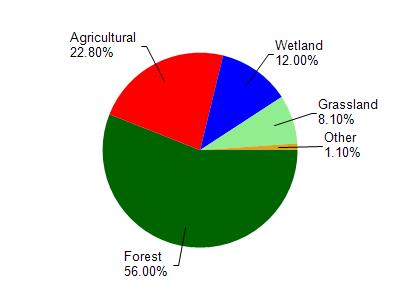
5.92 Miles
0 - 5.92
Macroinvertebrate, Cool-Cold Headwater
2015
Good
Clark
Yes
No
No
Fish and Aquatic Life
Overview
Scott Creek, in the South Fork Eau Claire River Watershed, is a 5.92 mile river that falls in Clark County. This river is a Class II Trout Water under the Fisheries Program. This river is managed for fishing and swimming and is currently not considered impaired.
Date 2011
Author Aquatic Biologist
Historical Description
Scott Creek T26N, R4W, S25, Surface Acres = 1.8, Miles = 3 .O, Gradient 23.3 feet per mile.
A soft water, medium brown colored stream that flows westward and joins
Hay Creek. Classified as a brown trout stream. Stocking has been discontinued
because of poor water quality. Natural trout reproduction is poor. About
60 percent of the land in the watershed is wooded or wild and 40 percent of the
bank border is wetland. The aerial groundwater survey conducted during the winter
of 1963 found a small area of open water near the north edge of Section 32. There
are two miles of public frontage through county forest cropland. Beaver are
present. Access is possible from one road crossing.
From: Klick, Thomas A. and C.W. Threinen, 1965. Surface Water Resources of Clark County:
Lake and Stream Classification Project. Wisconsin Conservation Department, Madison, WI.
Date 1965
Author Surface Water Inventory Of Wisconsin
Condition
Wisconsin has over 84,000 miles of streams, 15,000 lakes and milllions of acres of wetlands. Assessing the condition of this vast amount of water is challenging. The state's water monitoring program uses a media-based, cross-program approach to analyze water condition. An updated monitoring strategy (2015-2020) is now available. Compliance with Clean Water Act fishable, swimmable standards are located in the Executive Summary of Water Condition in 2018. See also the 'monitoring and projects' tab.
Reports
Recommendations
Citizen-Based Stream Monitoring
Collect chemical, physical, and/or biological water quality data to assess the current overall stream health. The data can inform management decisions and may be used to identify impaired waters for biennial lists.
Management Goals
Wisconsin's Water Quality Standards provide qualitative and quantitative goals for waters that are protective of Fishable, Swimmable conditions [Learn more]. Waters that do not meet water quality standards are considered impaired and restoration actions are planned and carried out until the water is once again fishable and swimmable
Management goals can include creation or implementation of a Total Maximum Daily Load analysis, a Nine Key Element Plan, or other restoration work, education and outreach and more. If specific recommendations exist for this water, they will be displayed below online.
Monitoring
Monitoring the condition of a river, stream, or lake includes gathering physical, chemical, biological, and habitat data. Comprehensive studies often gather all these parameters in great detail, while lighter assessment events will involve sampling physical, chemical and biological data such as macroinvertebrates. Aquatic macroinvertebrates and fish communities integrate watershed or catchment condition, providing great insight into overall ecosystem health. Chemical and habitat parameters tell researchers more about human induced problems including contaminated runoff, point source dischargers, or habitat issues that foster or limit the potential of aquatic communities to thrive in a given area. Wisconsin's Water Monitoring Strategy was recenty updated.
Grants and Management Projects
Monitoring Projects
| WBIC | Official Waterbody Name | Station ID | Station Name | Earliest Fieldwork Date | Latest Fieldwork Date | View Station | View Data |
|---|
| 2140000 | Scott Creek | 10010470 | Scott Creek - Scott Creek Station 2 Cth M | | | Map | Data |
| 2140000 | Scott Creek | 10034990 | Scott Creek DS of CTH M - Fish Station | 1/1/2015 | 1/1/2015 | Map | Data |
| 2140000 | Scott Creek | 10034991 | Mouth of Scott Creek - Fish Station | 1/1/2015 | 1/1/2015 | Map | Data |
| 2140000 | Scott Creek | 10020893 | Scott Creek At Cth M | 5/16/2007 | 1/1/2015 | Map | Data |
| 2140000 | Scott Creek | 10010469 | Scott Creek - Scott Creek Station 1 Upstream Of Mouth | | | Map | Data |
|

Watershed Characteristics
Scott Creek is located in the South Fork Eau Claire River watershed which is 229.49 mi². Land use in the watershed is primarily forest (56%), agricultural (22.80%) and a mix of wetland (12%) and other uses (9.20%). This watershed has 421.59 stream miles, 307.67 lake acres and 23,719.61 wetland acres.
Nonpoint Source Characteristics
This watershed is ranked Low for runoff impacts on streams, High for runoff impacts on lakes and Medium for runoff impacts on groundwater and therefore has an overall rank of Medium. This value can be used in ranking the watershed or individual waterbodies for grant funding under state and county programs.However, all waters are affected by diffuse pollutant sources regardless of initial water quality. Applications for specific runoff projects under state or county grant programs may be pursued. For more information, go to surface water program grants.
Scott Creek is considered a Macroinvertebrate, Cool-Cold Headwater under the state's Natural Community Determinations.
Natural communities (stream and lake natural communities) represent model results and DNR staff valiation processes that confirm or update predicted conditions based on flow and temperature modeling from historic and current landscape features and related variables. Predicated flow and temperatures for waters are associated predicated fish assemblages (communities). Biologists evaluate the model results against current survey data to determine if the modeled results are corect and whether biological indicators show water quaity degradation. This analysis is a core component of the state's resource management framework. Wisconsin's Riverine Natural Communities.
Cool (Cold-Transition) Headwaters are small, usually perennial streams with cold to cool summer temperatures. Coldwater fishes are common to uncommon (<10 per 100 m), transitional fishes are abundant to common, and warm water fishes are uncommon to absent. Headwater species are abundant to common, mainstem species are common to absent, and river species are absent.